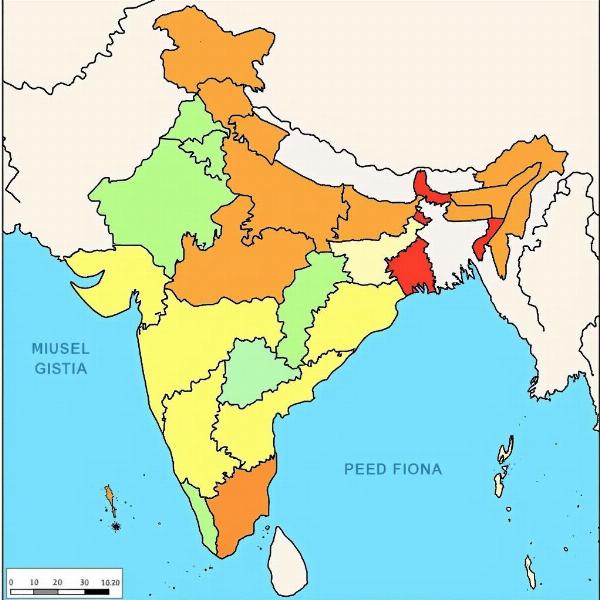The search term “linguistic states meaning in Hindi” indicates a desire to understand how India’s states are organized based on language. This involves not only the translation of the term but also a deeper understanding of the historical, political, and cultural implications of language-based state formation in India. This article delves into the nuances of this concept, exploring its historical context, significance, and impact on India’s diverse linguistic landscape.
The Genesis of Linguistic States in India
The reorganization of Indian states along linguistic lines was a significant event in post-independence India. It aimed to address the administrative and political challenges posed by the country’s immense linguistic diversity. Prior to independence, states were largely demarcated based on historical and political considerations, often disregarding linguistic boundaries. This led to discontent and calls for states based on shared language, reflecting a desire for self-determination and cultural preservation.
 Linguistic States Map of India
Linguistic States Map of India
The formation of linguistic states was a complex and gradual process. One of the earliest examples was the formation of Andhra Pradesh in 1953, following protests and demands for a separate Telugu-speaking state. This event set a precedent for other linguistic groups, leading to the States Reorganisation Act of 1956, which redrew the map of India based on linguistic considerations. This act was a landmark moment in Indian history, recognizing the importance of language in shaping political and administrative boundaries.
“भाषाई राज्य” (Bhashai Rajya): The Hindi Term and its Significance
The Hindi term for “linguistic states” is “भाषाई राज्य” (Bhashai Rajya). “भाषाई” (Bhashai) means linguistic, and “राज्य” (Rajya) means state. This term reflects the core principle of organizing states based on the predominant language spoken by the population. It signifies the recognition of language as a unifying factor and a crucial element of cultural identity.
The emphasis on linguistic states underscores the importance of language in governance, education, and cultural expression. It allows for greater accessibility to government services and fosters a sense of belonging among people who share a common language.
Challenges and Benefits of Linguistic States
While the formation of linguistic states has largely been successful, it has also presented certain challenges. The demarcation of boundaries based on language is not always straightforward, and disputes can arise over border regions where multiple languages are spoken. Additionally, linguistic reorganization has not entirely eliminated inter-state linguistic tensions, and issues related to language rights and representation continue to exist.
However, the benefits of linguistic states are undeniable. They have empowered linguistic minorities, facilitated administrative efficiency, and promoted cultural preservation. They have also strengthened democratic processes by enabling greater participation from diverse linguistic groups.
Looking Ahead: Language and Federalism in India
The concept of linguistic states continues to evolve in contemporary India. Issues related to language rights, linguistic minorities, and the promotion of multilingualism remain important topics of discussion and debate. The balance between linguistic identity and national integration is an ongoing challenge that requires careful consideration and inclusive policies.
Conclusion: Linguistic States – A Cornerstone of Indian Federalism
The formation of linguistic states, or “भाषाई राज्य” (Bhashai Rajya), represents a crucial aspect of India’s federal structure. While challenges remain, the reorganization of states along linguistic lines has significantly contributed to democratic governance, cultural preservation, and the empowerment of linguistic communities. Understanding the meaning and significance of linguistic states is essential for comprehending the complexities of India’s diverse linguistic and political landscape.
FAQ
- What does “linguistic states” mean? Linguistic states are administrative divisions within a country organized based on the predominant language spoken by the population.
- Why were linguistic states created in India? Linguistic states were created to address administrative challenges, promote cultural preservation, and empower linguistic communities.
- What is the Hindi term for “linguistic states”? The Hindi term for “linguistic states” is “भाषाई राज्य” (Bhashai Rajya).
- What are some challenges associated with linguistic states? Challenges include border disputes and ongoing tensions related to language rights.
- What are the benefits of linguistic states? Benefits include administrative efficiency, cultural preservation, and empowerment of linguistic minorities.
- What is the States Reorganisation Act of 1956? This act redrew the map of India based on linguistic considerations.
- What is the significance of Andhra Pradesh’s formation in 1953? It set a precedent for other linguistic groups demanding separate states.
Meaning-Hindi.in is your trusted partner for all your Hindi translation needs. We offer a comprehensive range of translation services, specializing in business and commercial documents, legal and certified translations, technical manuals, website localization, educational and academic materials, and express translation services. Our expertise also covers various specialized fields. Whether you need to translate your website for a Hindi-speaking audience or require accurate legal document translation, Meaning-Hindi.in provides high-quality, culturally sensitive, and reliable solutions. Contact us today at [email protected] or call us at +91 11-4502-7584.